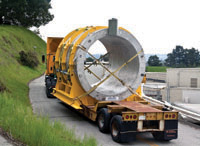Old detectors never die
 |
| A truck moves a 15-ton superconducting magnetic coil from the BaBar detector to a storage area at SLAC. Photo: Lori Ann White |
Although BaBar completed its experimental run in 2008, it's not bound for the graveyard. Instead, the detector has become the particle physics version of an organ donor: Other laboratories are making use of its disassembled parts.
“There is a desire for these parts from a lot of places,” says Bill Wisniewski of SLAC National Accelerator Laboratory, who is managing the decommissioning and dispersal project. “Some parts are in demand by multiple groups, so we'll have to decide how to distribute them.”
Located at SLAC, the BaBar experiment had five layers of detectors for measuring and identifying particles created in electron-positron collisions.
It's the third layer, called DIRC, that had physicists salivating. DIRC stands for Detection of Internally Reflected Cherenkov light. It contained 144 quartz bars that formed a 12-sided shell around the beamline. When a charged pion or kaon from a particle collision hit the quartz, a flash of Cherenkov light would be picked up by an array of 11,000 photomultiplier tubes and used to identify the particle type.
“The DIRC detector was state of the art when it was built, and it's still state of the art now,” Wisniewski says.
Three thousand of those photomultiplier tubes have already been shipped to the DOE's Jefferson Lab in Virginia, he said. The remaining 8000 tubes are available for re-use in experiments that have need of them.
The quartz bars, the mechanical structure that supported them, and the steel support structure for the entire detector are expected to go to the SuperB project in Italy. In the meantime, the quartz bars await their destiny in a temperature-controlled storage area on the SLAC site.
SuperB is also interested in re-using BaBar's 6500-crystal electromagnetic calorimeter, which measures the energy of particles, and a solenoid, whose magnetic field bends the tracks of charged particles to help determine their charge and momentum.
And so BaBar, which studied the building blocks of the universe, will live on in the next generation of discovery machines.
Lauren Rugani
Click here to download the pdf version of this article.






